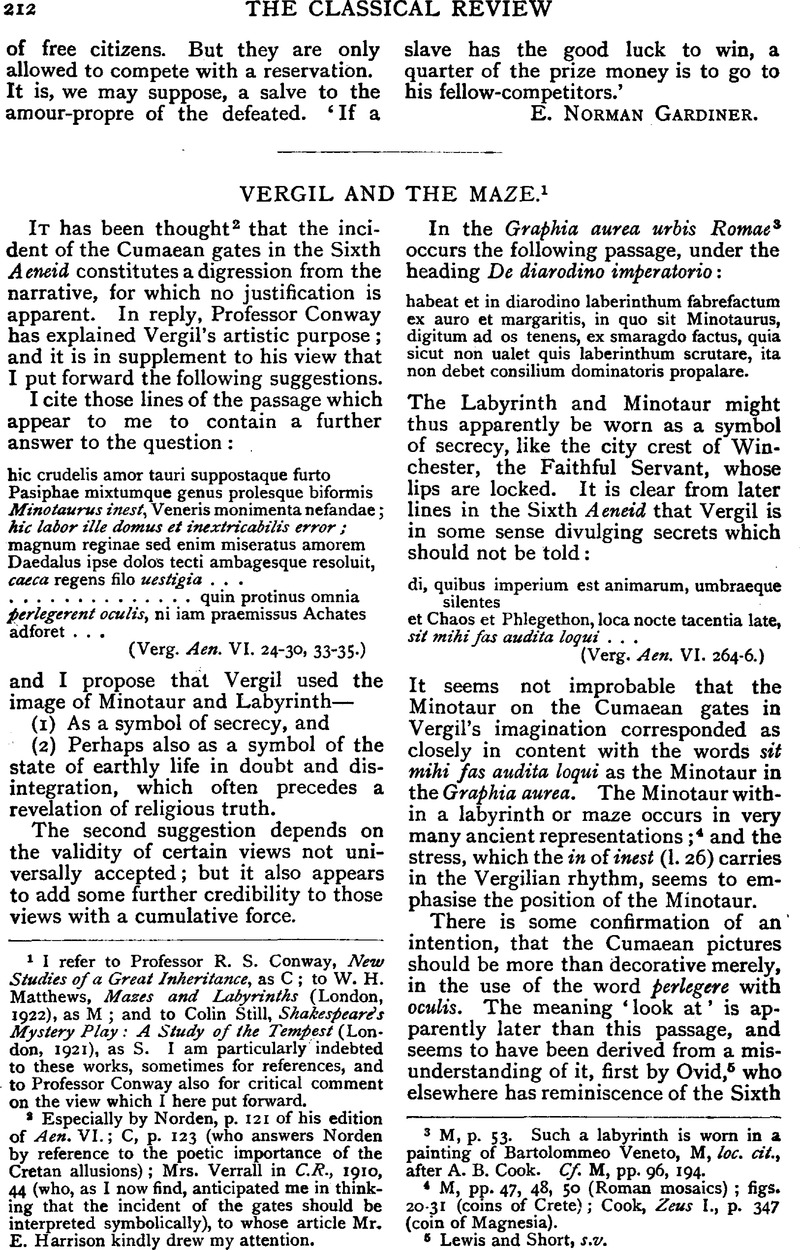Published online by Cambridge University Press: 27 October 2009

page 212 note 2 Especially by Norden, p. 121 of his edition of Aen. VI.; C, p. 123 (who answers Norden by reference to the poetic importance of the Cretan allusions); MrsVerrall, in C.R., 1910, 44Google Scholar (who, as I now find, anticipated me in thinking that the incident of the gates should be interpreted symbolically), to whose article Mr. E. Harrison kindly drew my attention.
page 212 note 3 M, p. 53. Such a labyrinth is worn in a painting of Bartolommeo Veneto, M, loc. cit., after A. B. Cook. Cf. M, pp. 96, 194.
page 212 note 4 M, pp. 47, 48, 50 (Roman mosaics); figs. 20–31 (coins of Crete); Cook, Zeus I., p. 347 (coin of Magnesia).
page 212 note 5 Lewis and Short s.v.
page 213 note 1 Cf. uariarum mnonstra ferarum in Verg. Aen. VI. 285, and Ov. Met. XIV. 414.
page 213 note 2 W. B. Yeats, Ideas of Good and Evil, passim ; cf. Whitehead, Symbolism (where the concept is transferred to metaphysic).
page 213 note 3 Knight, G. Wilson, Myth and Miracle, pp. 16, 25Google Scholar; id. in Shakespeare Review, September, 1928 : who regards a study of poetic symbolism as the basis of the literary criticism of Shakespeare.
page 213 note 4 That is, the state familiar in Hamlet, Bunyan's Slough of Despond, analysed by William James, Varieties of Religious Experience. Cf. Francis Thomson, Hound of Heaven, 3, 4 : ‘labyrinthine ways of my own mind.’
page 213 note 5 Divina Legatio, Book II., Sec. 4.
page 213 note 6 S, pp. 132, 133, quoting Lucian's ‘blind march’ (cf. caeca uestigia in Verg. Aen. VI. 30) in Catapl. 22, and Plat. Phaedo IO8A.
page 213 note 7 S, p. 27, quoting, after Warburton, Stob. Serm. CXIX.; p. 28; p. 61 quoting Ecclus. IV. 17–19; Tempest III. iii. Still is primarily concerned to show in detail that The Tempest represents a ‘Universal Myth’ of the path to salvation, found also in O.T., N.T., Greek mystery religions, Aen. VI., the Divina Cornmedia, and elsewhere, and sustained generally with the same symbolism. C, pp. 165 ff., has demonstrated that The Tempest contains many exact reminiscences of Vergilian thought and expression: cf. S, Pt. II., ch. 2, etc.
There seems little doubt that mazes in Christian Churches of the Middle Ages were used for some symbolic tracing or treading with moral or religious intent: M passim, especially PP. 93 (penitence), 57, 68 (giving mediaeval inscriptions). At San Savino Church, Piacenza, the labyrinth is a symbol of the world; there is a narrow path out of it, which represented the natural man's path to spiritual life: M, P. 57.